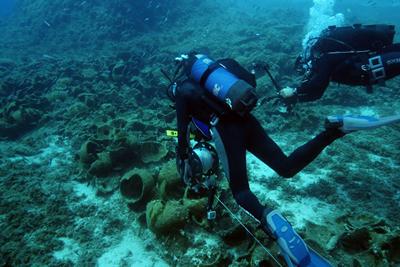Stunned Archaeologists find 22 Ancient Greek Shipwrecks

The recent "once in a lifetime discovery" of 22 shipwrecks were found in an area of just 17 miles around the archipelago of Fourni, which is in the middle of an ancient trade route between Greece, Egypt and Cyprus. This was the first underwater archaeological expedition to the islands.
The expedition was a collaboration between the Greek Ephorate of Underwater Antiquities (EUA) and RPM Nautical Foundation (RPMNF), directed by George Koutsouflakis (EUA), Jeffrey Royal (RPMNF), and Peter Campbell (RPMNF/University of Southampton).
The shipwrecks date from the Archaic Period (700-480 BC) though the Late Medieval Period (16th century). Several wrecks date to the Classical (480-323 BC) and Hellenistic (323-31 BC) periods, but over half of the wrecks date to the Late Roman Period (circa 300-600 AD). The ships’ cargos point to the importance of long distance trade between the Black Sea, Aegean Sea, Cyprus, the Levant, and Egypt in all these periods. The findings offer insight into ancient maritime connections, as well as rare discoveries. “What is astonishing is not only the number of the shipwrecks but also the diversity of the cargoes, some of which have been found for first time,” says Greek director George Koutsouflakis. At least three of the sites have cargoes that have not been found previously on shipwrecks.
Archaeologists mapped each shipwreck using photogrammetry to create 3D site plans. Representative artifacts were excavated and raised from each wreck site for scientific analysis. These artifacts are currently undergoing conservation at the Ephorate’s laboratory in Athens and may go on displays in museums in the future.
The discovery adds 12% to the total number of known ancient shipwrecks in Greece. The findings suggest a great quantity of the shipwrecks await discovery in Fourni. “In a typical survey we locate four or five shipwrecks per season in the best cases,” says Koutsouflakis. “We expected a successful season, but no one was prepared for this. Shipwrecks were found literally everywhere.”
For comparison, the United States recently created a national marine sanctuary in Lake Michigan to protect 39 known shipwrecks located in 875 square miles. Fourni now has 22 known shipwreck in 17 square miles. The previous record in Greece for a season was 10 ancient wrecks discovered over 10 days during a 2008 survey in Chios.
“The concentration of ancient shipwrecks is unprecedented,” says Peter Campbell, co-director from US based RPM Nautical Foundation. “The volume of shipwrecks in Fourni, an island that had no major cities or harbors, speaks to its role in navigation as well as the perils of sailing the eastern Aegean.”
Less than 5% of Fourni’s coastline has been explored for underwater cultural heritage. Local fishermen and sponge divers have reported many more leads that will be followed up in future seasons. “The local response to the project has been incredible and it is through working with the community that we were able to exceed expectations,” says Campbell. “Archaeology is about people; those in the past as well as those in the present. The highlight has been bringing the past back to life for people that are engaged with their history.”
The team plans to return next year to continue the survey.
Notes for editors
1. Please refer to the Hellenic Ministry of Culture press release for more information and photographs. http://www.yppo.gr/2/g20.jsp
2. The Ephorate of Underwater Antiquities is a division of the Hellenic Ministry of Culture responsible for Greece’s underwater cultural heritage.
3. RPM Nautical Foundation is a US 501(c)(3) nonprofit dedicated to scientific research and education in the Mediterranean Sea. http://www.rpmnautical.org/